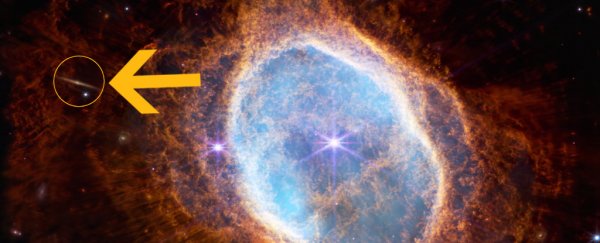If you're still geeking out over the first release of full-color James Webb Space Telescope images, you're not alone. This week we were treated with the very first image unveiling, shortly followed by four other brand new images that show our Universe in never-before-seen detail – and we've hardly been able to stop staring at them.
But there's one very important detail we missed at first glance!
Located stealthily in the upper left of the Southern Ring Nebula images is what looks like a streak of light – but is actually a side view of a galaxy.
 Southern Ring Nebula images with the side-view galaxy circled. (NASA, ESA, CSA, and STScI)
Southern Ring Nebula images with the side-view galaxy circled. (NASA, ESA, CSA, and STScI)
"I made a bet that said 'It's part of the nebula'," said NASA astronomer Karl Gordon during the image reveal, Business Insider reports. "I lost the bet, because then we looked more carefully at both NIRcam [Near-Infrared Camera] and MIRI [Mid-Infrared Instrument] images, and it's very clearly an edge-on galaxy."
Not only does it look cool, but this perspective should allow astronomers to study how stars are distributed throughout the galaxy.
In case you missed it yesterday, what you're looking at are spectacular waves of death from the Southern Ring Nebula – a massive dust and gas cloud located around 2,000 light-years away.
There are two stars in its center. The fainter one is a white dwarf – the collapsed core of a dead star – that, during its lifetime, was up to eight times the mass of the Sun.
It reached the end of its life, blew off its outer layers, and the core collapsed down into an ultradense object: up to 1.4 times the mass of the Sun packed into an object the size of Earth.
For the first time, the JWST has been able to reveal that this star is cloaked in dust.
The brighter star is in an earlier stage of its evolution and will one day explode into its own nebula.
On the left, the JWST's Near-Infrared Camera reveals bubbly orange hydrogen from newly formed expansions as well as a blue haze of hot ionized gas from the dead star's leftover heated core.
On the right, in the image captured by JWST's Mid-Infrared Instrument, blue hydrocarbons form patterns similar to the orange in the previous image, because they gather on the surface of hydrogen dust rings.
You can read more about the Southern Ring Nebula images over at the NASA site.
